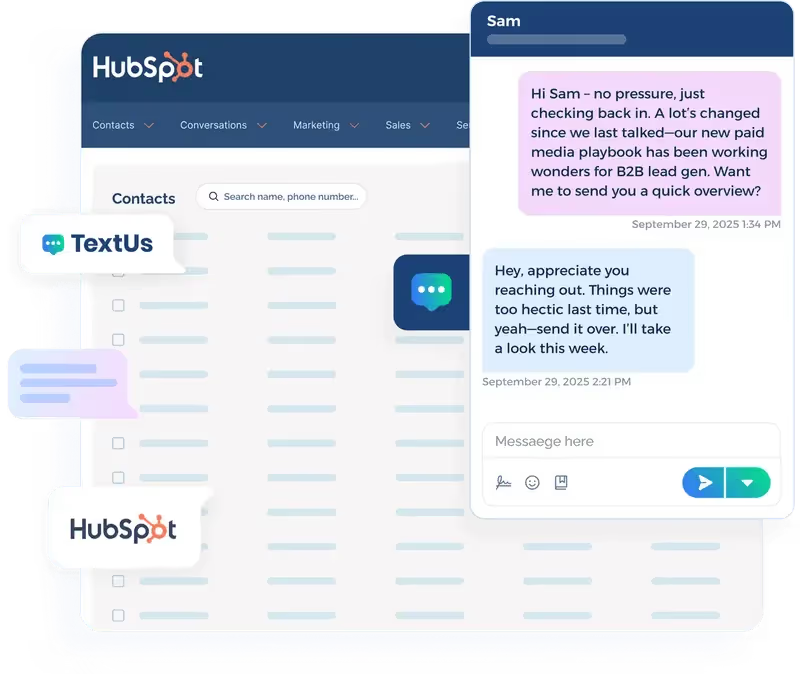How Conversational SMS Marketing Turns Messages Into Sales
Learn how conversational SMS marketing can improve your business and explore best practices. Discover how TextUs can help you out.
Published
November 12, 2025

Texting has always been a fast way to communicate, but now companies use it to do more than send updates or coupons.
Through conversational text marketing, a customer can ask about a product, confirm an appointment, or get help in real time through a simple text.
But many businesses struggle to keep messages relevant without sounding robotic or repetitive. Others find it hard to respond quickly enough to keep people interested.
In this article, we’ll explore how conversational SMS marketing transforms everyday messages into genuine sales opportunities.
You’ll also learn how the best SMS marketing platform helps create personalized interactions that boost conversions and keep customers coming back for more.
How SMS Marketing Creates Engaged Customers
People are glued to their phones, and texting is often their favorite way to communicate. Studies show that 98% of SMS messages are opened, and most are read within three minutes.
Compared to emails, where open rates hover around 20%, it’s clear why SMS marketing has become popular for businesses.
The convenience of two-way communication makes texting a natural fit for modern buyers. A customer can ask a quick question about a product or request support without switching platforms.

When customers can chat naturally with your brand, you gain insights into what they like, what they need, and what stops them from buying. This makes conversational commerce not only a support tool but also a source of real-time market feedback.
Another key factor is how short, mobile interactions shape customer expectations. People check their phones several times an hour, so SMS messaging meets them where they already are.
If you keep up with this communication style, you'll see stronger customer relationships because you meet customers on their terms. A quick text message can replace slow email threads or missed phone calls, saving time while keeping customers engaged.
In short, conversational texting boosts response and conversion rates. It keeps your marketing efforts human-centered and supports better follow-ups through personalized interactions.
Why Every Business Needs Conversational SMS Marketing
The strength of conversational texting lies in its ability to build real connections with people. Instead of sending cold, one-directional blasts, you can use two-way SMS to create actual dialogue.
Builds Trust and Real Connections
Through personalized interactions, people feel like they’re speaking to a real person instead of a faceless brand. When you use customized messaging like remembering names, preferences, or purchase history, it strengthens trust.
This is true when customers receive timely updates, reminders, or follow-ups that match their needs. That personal touch turns new customers into repeat buyers and even VIP customers who stay loyal to your brand.
Drives More Conversions and Sales
Quick replies and automated messages make it easy to guide people through the buying process. When customers ask questions, these responses can instantly provide details about stock, shipping, or pricing, speeding up decisions.
Real-time replies can help convert leads before they lose interest. This method provides higher ecommerce sales. Conversational SMS enables you to recommend products, send targeted promotions, or share personalized recommendations that match customer preferences.
Strengthens Customer Support and Experience
Most buyers don’t want to be put on hold or redirected. With customer support handled through texts, you can solve support inquiries right where the conversation started.
Text-based help is fast and direct, which leads to higher customer satisfaction. Using effective conversational SMS tools, you can also reduce pressure on your teams by letting automation handle common questions while keeping live agents available for complex issues.
Use Cases of Conversational SMS Marketing
Conversational SMS marketing is far more than a way to send updates. It’s a flexible system that fits every part of the customer journey. Here are some of the most profitable use cases where conversational texting makes a real difference.
Lead Nurturing and Onboarding
Conversational SMS marketing makes it easier to move leads from signup to loyal customer status.
A welcome text message sent right after someone joins builds an immediate connection and sets expectations. Short follow-ups, such as onboarding tips, setup guidance, or basic instructions, help people understand your product.
After the first few messages, communication should continue in a natural and helpful tone. Regular check-ins, updates, and reminders help strengthen engagement without overwhelming the recipient.
This process builds confidence and trust, allowing customers to feel supported as they explore your service.
Customer Support and Issue Resolution
Customer service has evolved from waiting on hold to fast, conversational texting. With customer text message service, you can provide real-time customer support through direct, two-way conversations.
Simple automated responses can handle basic requests like tracking numbers or business hours, while more complex issues are passed to live agents for personalized attention.
Continuous text-based communication also helps you gather useful feedback about recurring problems or service gaps. Insights from these customer interactions can improve internal processes and strengthen future communication.
Promotions and Personalized Offers
SMS marketing campaigns work best when they feel like part of a conversation rather than another generic promotion. The key is to connect every offer to what the recipient cares about by using simple language and perfect timing.
If you're in the ecommerce, hospitality, and healthcare industries, conversational texting keeps your communication relevant throughout the entire customer journey.
You can send personalized messages tied to customer history, like appointment follow-ups, seasonal offers, or loyalty perks. This direct interaction creates a personal connection that strengthens trust.
Appointment Scheduling and Reminders
Texting is ideal for managing appointments. Customers use a direct line to confirm, move, or cancel times, and teams can respond instantly to customer inquiries without phone tag or inbox delays.
Personalized timing and content also raise attendance and satisfaction. You can send customized messages for confirmations, prep notes, and post-visit check-ins. Then, use customer insights to time nudges that engage customers.
A friendly tone builds personal connection, supports the entire customer journey, and helps boost engagement with steady, relevant touchpoints.
Abandoned Cart and Post-Purchase Follow-Ups
You can use SMS campaigns to recover lost sales. When someone leaves items in their cart, a quick reminder text sent through SMS gets them to return and finish the checkout process.
Post-sale follow-ups extend the relationship beyond the transaction. You can send personalized messages such as thank-yous, delivery updates, or simple satisfaction check-ins.
Regular follow-ups help engage customers, strengthen personal connections, and boost engagement with future offers or loyalty programs.
Surveys and Feedback Collection
Two-way SMS conversations are ideal for gathering opinions after purchases, events, or support inquiries. Texting makes it easy for people to reply.
These quick customer surveys create valuable data that shapes future interactions and helps identify patterns in customer preferences or customer behavior.
Compared to long online forms, SMS surveys feel lighter and more personal, and customers are more likely to respond.
Re-Engaging Inactive or Lost Customers
Rather than letting old contacts fade away, you can use friendly text messages to restart the relationship. This reminds people that the brand still values them.
Messages should be thoughtful, which is something that shows genuine interest in the person’s experience. Follow-ups might include a small discount, a product restock alert, or a question about what made them step away.
Internal Communication and Team Coordination
Conversational texting isn’t only for customers. You can use SMS technology internally to coordinate teams, confirm meetings, or share updates across multiple marketing channels.
Because texting has high visibility, it’s a reliable method for real-time collaboration that keeps staff aligned and responsive.
8 Best Practices for Effective Conversational SMS Marketing
Using conversational business texting the right way takes more than just sending a few messages. It should also be about timing, tone, and thoughtfulness.
Below are a few best practices that help you build stronger customer relationships and increase repeat purchases.
1. Segment Conversations Based on Intent
Every customer reaches out for a different reason. Lumping all of them into the same conversation flow is a guaranteed way to lose engagement.
SMS segmentation by customer intent helps keep your communication personal.

Start by identifying the main purposes behind your incoming conversations: questions about products, new subscribers seeking help with setup, or inactive customers returning after months of silence.
Then, you can create unique conversation paths for each. For example, you may send automated messages with order tracking details for purchase questions, but forward complaints to a live agent right away.
Segmenting also helps in tracking customer behavior over time. You can learn which groups respond best to targeted promotions, which are likely to make repeat purchases, and which prefer quick automated responses.
2. Create Personality-Driven Replies
The tone of your sales messages says more about your brand than any logo or tagline. Using personality-driven replies in conversational texting makes every chat sound friendly and memorable.
You need to assess if you're business is more relaxed and humorous. Then, you can use that tone in both human and automated responses.
Instead of a plain “Your order has shipped,” try: “Good news — your package is on its way! We’ll text again when it lands.” It’s still clear, but much warmer. This approach strengthens customer relationships and keeps customers engaged longer.
Personality doesn’t mean being unprofessional. You can keep it natural and aligned with your audience’s comfort level.
If your business serves a younger demographic, emojis or short, energetic phrases may work. For more formal industries, simple warmth is enough. The goal is to make text messages sound like a genuine conversation, not a broadcast.
3. Use Smart Triggers for Timing and Context
SMS timing can make or break your marketing campaigns. Smart triggers use customer data to track behavior and send relevant messages automatically.
For example, when a customer adds something to their cart but doesn’t buy, your system can send a friendly reminder or discount offer. When someone completes an order, send a thank-you note or appointment reminders for services that need follow-up.

It’s also useful for identifying the best time to send SMS campaigns. Instead of blasting out promotional messages at random hours, you have to analyze customer preferences and activity history to find ideal windows for outreach.
Finally, smart triggers help you predict what comes next in the customer journey. You can prepare future messages and future interactions based on actions already taken. This could be recommending products, sending targeted promotions, or thanking repeat customers.
4. Build Continuous Conversations
Too many brands treat texting as a one-and-done announcement. But conversational text messaging works best when you keep customers engaged long after the first interaction.
Instead of ending communication after a purchase or signup, use two-way SMS to stay connected. You can follow up with a thank-you note, request feedback, or send personalized recommendations based on customer behavior.
If a shopper buys skincare products, message them a few weeks later with a restock reminder or offer targeted promotions for related items. This approach turns transactional chats into long-term relationships.
5. Integrate SMS Into Broader Marketing Systems
The best SMS strategy is one that fits neatly into your entire marketing ecosystem. When you integrate text marketing with other communication channels, you can create consistent communication across every touchpoint in the customer journey.

Start by connecting your SMS marketing software with your CRM, email service, and ad manager. This makes it easier to share customer data across systems and use it for personalized interactions.
If someone clicks a link in a Facebook ad but doesn’t buy, you can send a follow-up text message with a limited-time offer. Or if a customer reads your newsletter, you can trigger relevant messages via SMS to move them closer to a purchase.
SMS integration also simplifies tracking. You can see how multiple marketing channels work together and which ones drive the most responses.
A unified view helps measure your SMS performance, identify customer preferences, and guide future campaigns based on solid, valuable data.
6. Keep Message Frequency in Check
No one enjoys being bombarded with texts, not even your most loyal customers. A smart SMS marketing strategy respects customers' attention and SMS timing.
Sending too many text messages makes people unsubscribe, while sending too few makes them forget you exist. The goal is to find a rhythm that keeps customers engaged and matches their customer preferences.
A good baseline is one or two texts per week, but it depends on your business type and audience.
If you're a retail brand, you might send more targeted promotions around holidays or sales, while as a service-based company, you can focus on appointment reminders or updates.
You need to pay attention to customer responses and adjust frequency based on engagement. If reply rates drop or unsubscribe rates climb, you’re probably sending too much.
Finally, always let customers choose how often they hear from you. You can offer easy options to pause, snooze, or reduce frequency instead of forcing an unsubscribe. It shows customers feel valued and gives you more long-term retention.
7. Monitor Keyword Triggers for Feedback
Keyword triggers are one of the most overlooked tools in conversational messaging, yet they play a huge role in improving customer engagement and service quality.
When you set up specific SMS keywords that customers can text, such as “HELP,” “ORDER,” or “STOP,” you create shortcuts that lead to fast automated responses and smoother two-way messaging.
For example, if a customer replies “STATUS,” your system can instantly send their order tracking link through an automated message. Or if someone texts “DISCOUNT,” it can respond with a list of targeted promotions.
Also, if you notice frequent “HELP” messages, it might signal confusion in your checkout process. A spike in “STOP” replies could mean you’re sending too many text messages or not delivering relevant messaging.
SMS keyword-based interactions create instant responses without requiring human support, saving time while maintaining a quick customer experience.
8. Keep Compliance Front and Center
Compliance in conversational business texting is a foundation of trust. Every message reflects how much your brand respects customer data and privacy.
Regulations such as the Telephone Consumer Protection Act (TCPA) require consent, transparent communication, and immediate respect for SMS opt-out requests.

Clear consent must come first before launching SMS campaigns. Each contact should willingly opt in and know what type of marketing messages they’ll receive.
Double SMS opt-ins, where people confirm their subscription after an initial text, also keep your lists accurate and engagement high. A smaller, permission-based list always outperforms a large, unverified one because those who sign up are genuinely interested.
Customers should always have control over the conversation. Every message should include a clear way to stop receiving texts, like “Reply STOP to unsubscribe.” Prompt action on these replies keeps your communication honest and strengthens brand loyalty.
Make Every Text an Opportunity to Connect—Try TextUs!
If you want faster replies, stronger relationships, and communication that gets noticed, TextUs makes conversational texting effortless. It turns everyday messages into real conversations that drive results.
With one easy-to-use platform, you can reach people instantly, stay personal at scale, and finally give your audience the quick, human response.
TextUs helps your team manage interactions with smart automation, real-time notifications, and integrations that keep your workflows simple. You can send personalized updates, handle customer questions, or follow up on opportunities without losing that one-on-one touch.
If you’re ready to move past outdated communication tools, it’s time to make texting your competitive edge.

Book a demo with TextUs today and see how conversational SMS can transform the way your business connects!
FAQs About Conversational SMS Marketing
Is SMS marketing legal in the USA?
Yes, text marketing is legal in the United States, but it’s strictly regulated. The TCPA requires businesses to get written consent before sending any promotional text messages. Customers must opt in knowingly without pre-checked boxes or surprise subscriptions.
Every campaign should also include an easy way to opt out, such as replying “STOP.” Compliance protects both the brand and the consumer.
What is replacing SMS?
While SMS remains powerful, many brands are expanding to multiple marketing channels like WhatsApp, Facebook Messenger, and in-app chat tools.
Still, SMS technology remains unmatched for direct reach because nearly every phone can receive text messages. The future likely blends conversational messaging and app-based chat systems, combining convenience with personalization.
Is SMS marketing still effective?
Absolutely. SMS continues to outperform most other marketing channels in open and response rates. Studies show that text messages have around a 98% open rate, while email averages about 20%.
When paired with SMS marketing automation and personalization, it becomes a powerhouse for engagement.
Continue Reading
Frequently Asked Questions
Business Texting
Built for Results
Create and convert pipeline at scale through industry leading SMS software




